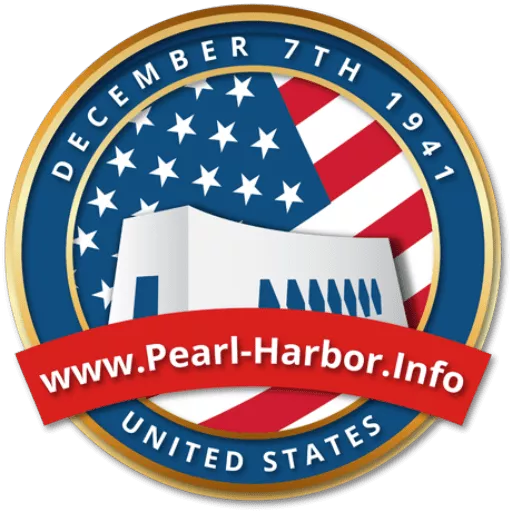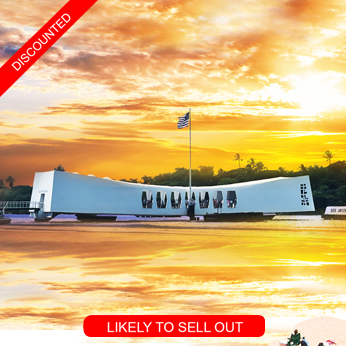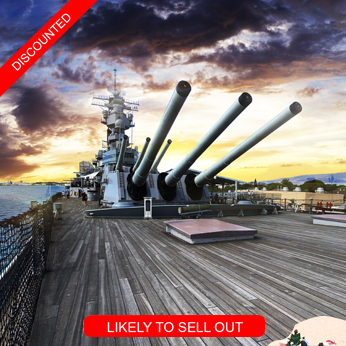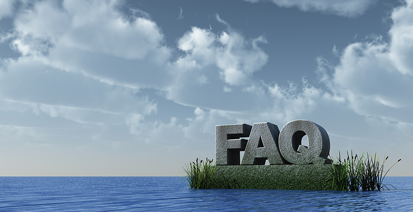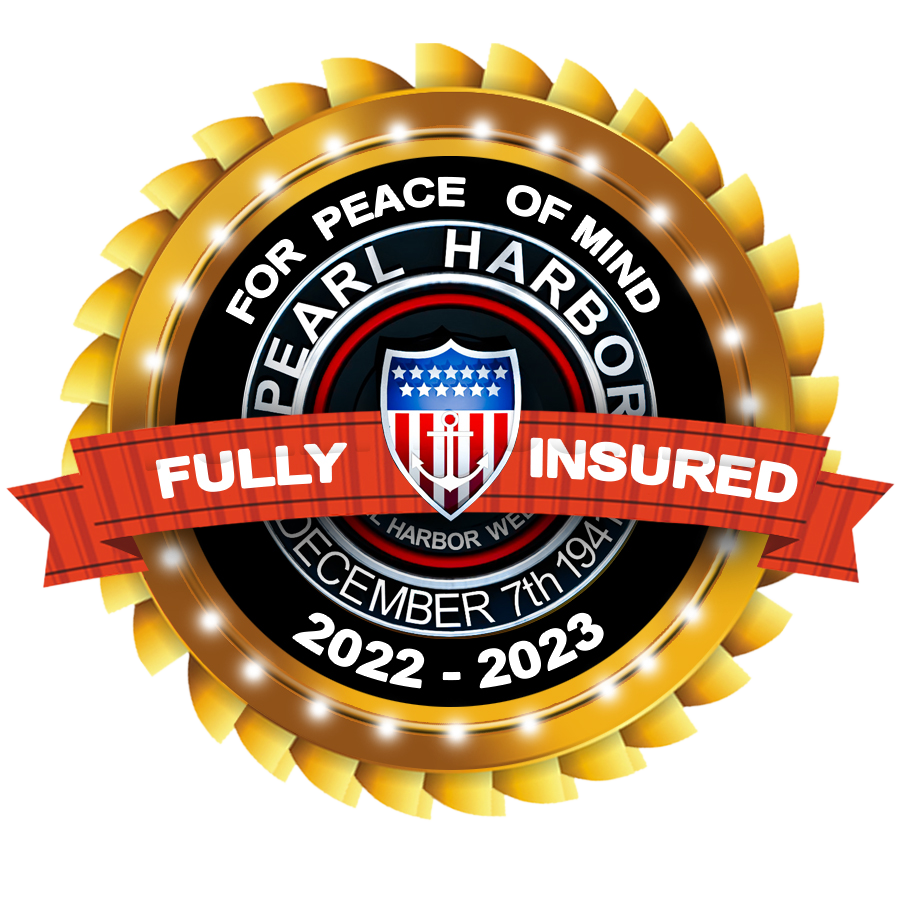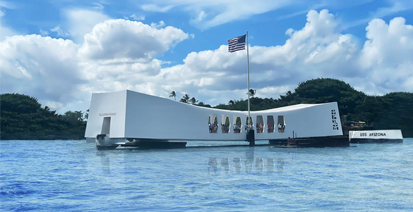Pearl Harbor National Memorial – Pearl Harbor Historic Sites
USS Bowfin Submarine And Pacific Fleet Submarine Museum

The entrance to the USS Bowfin Submarine and Pacific Fleet Submarine Museum at the Pearl Harbor National Memorial.
Aside from the USS Arizona Memorial, the major attractions at the Pearl Harbor National Memorial are called the Pearl Harbor Historic Sites. The oldest of these historic sites, besides the Arizona Memorial, is the USS Bowfin Submarine. The Bowfin Submarine has been a museum since 1979 and has been a National Historic Landmark since 1986. This means that the USS Bowfin was a museum before the Pearl Harbor Visitor Center was constructed. No trip to Pearl Harbor is complete without a visit to the Submarine Bowfin Museum and Park. Come and learn about U.S. submarines, crew, and undersea warfare history, all in one incredible place. The USS Bowfin Submarine Museum sits on 2.5 acres. Along the shoreline of historic Pearl Harbor and is located adjacent to the Pearl Harbor Visitor Center. The USS Bowfin Submarine, its Museum, Waterfront Memorial, and outdoor exhibits were created to illuminate the service, honor, and sacrifice of the men and women who served and continue to serve in the United States Submarine Force. The USS Bowfin Submarine and Park is located at the Pearl Harbor National Memorial and is open daily from 7 am to 5 pm (the last tour is at 4:30 pm). The facility is closed on New Year’s Day, Thanksgiving, and Christmas. Tickets to the USS Bowfin Submarine include access to the Pacific Fleet Submarine Museum as well as an included audio tour of both the USS Bowfin and the Pacific Fleet Submarine Museum. Each audio tour takes approximately 30 minutes. These tours are available in English, Japanese, Mandarin, Korean, French, Spanish, German, and French. The Bowfin Submarine Museum and Park are operated by the Pacific Fleet Submarine Memorial Association (PFSMA). PFSMA is a private, nonprofit membership 501(c)(3) organization registered with the State of Hawaii in December 1978. The primary mission of PFSMA is to restore and preserve the USS Bowfin (SS-287) as a Submarine Memorial to the 52 American Submarines and the nearly 3,600 submariners who sacrificed their lives during World War II. Today, the USS Bowfin Submarine is moored proudly within the site of the USS Arizona Memorial, ready to welcome visitors to the fabled era of WW II submarines and their crews. This place is filled with tales of men who served under extreme conditions with strength, bravery, and honor. Whether inspired by the journey’s sheer adventure or the crew’s amazing heroism, visitors come away from the USS Bowfin Submarine enriched and inspired by the U.S. submariners’ unique role in helping win the Pacific War.

The Submarine Bowfin at Bowfin Park is one of the Pearl Harbor Historic Sites located at the Pearl Harbor Visitor Center.
For decades, submarines were the Navy’s “Silent Service, “shrouded in a cloak of stealth and secrecy intended to keep enemies off guard and unaware of their true capabilities. In World War II, submarines represented only two percent of the U.S. fleet. Yet, they were responsible for destroying 30 percent of the Japanese Navy, including eight aircraft carriers, one battleship, and eleven cruisers. Including the largest ship ever sunk by a submarine, the Japanese aircraft carrier Shinano. During the Pacific War, the U.S. Submarine Force sank nearly 1,400 Japanese Navy merchant ships, sending a totaling 5.5 million tons to the bottom of the ocean. These feats are remarkable on their own, but one thing to consider is the fact that many of these accomplishments are done despite the fact that their primary weapons were extremely flawed. Designed in 1931, the Mk.14 torpedo was plagued with cost overruns and production issues. The production issues meant that there was a shortage of torpedoes going into WWII. These issues would not be solved until near the end of the war. The cost and shortage of torpedoes meant that there was no desire to conduct live fire testing. The lack of testing meant that fatal flaws in the torpedoes would not become apparent until they were actually used in war. The torpedoes had faulty gyros and could enter a circular run where they would circle around and possibly hit the ship that fired it. This has actually caused the loss of at least two ships. The magnetic influence detonator was faulty and would either detonate before reaching the target or not be triggered by the target. The contact detonator was also faulty, leading to the torpedo striking the target and failing to explode. The depth regulator was also faulty and could lead the torpedo to run too deep, harmlessly passing beneath the target. This list of problems, while not unique to American torpedoes, was allowed to go on despite reports from submarine commanders stating the deficiencies of their weapons. These problems would be ignored by the Bureau of Ordinance or blamed on the submariners not maintaining the torpedoes or not using them properly. Nevertheless, the problems with the torpedoes were eventually solved, and by 1944, they were working properly for the most part. Despite this, the U.S. submarine fleet dealt a crushing blow to the Japanese war effort. All but completely isolating Japan from its conquered territories.

The USS Bowfin Submarine is docked right next to the Ford Island Bridge within sight of the USS Arizona Memorial.
Launched: December 7, 1942
Commissioned: May 1, 1943; Decommissioned: February 12, 1947
Recommissioned: July 27,1951; Decommissioned & Stricken: Dec 1, 1971
Length: 311 feet, 10 inches
Maximum Beam: 27 feet, 3 inches
Displacement: 1,525 tons (designed), 1,810 tons (diving), and 2,415 tons (submerged)
WWII Career: Nine patrols occur during the Pacific War. According to USS Bowfin, 44 enemy vessels were sunk (178,946 tons). The Joint Army-Navy Assessment Committee credited the Bowfin with 16 large ships (67,882 tons), plus ten boats of less than 500 tons each.
Awards:
1. Presidential Unit Citation
2. Navy Commendation
3. Philippine Republic -President Citation.
USS Bowfin’s Post-WWII Career:
Korean War: 1951-1954.
Training Boat: 1960-1971.
Museum Duty: 1979-present.
Opened to Public: 4/1/1981.
National Historic Landmark: 1986

The after torpedo room of the submarine Bowfin. The USS Bowfin submarine carried up to 24 torpedoes.
The USS Bowfin (SS-287) was a Balao-Class submarine built at the Portsmouth Naval Shipyard. She was launched on December 7, 1942, leading to her being called the “Pearl Harbor Avenger.” The USS Bowfin was armed with six 21-inch torpedo tubes forward and four 21-inch torpedo tubes aft with a load of 24 torpedoes. She was also armed with one 5-inch/25 caliber deck gun, one 40mm, and one 20mm anti-aircraft gun. She had a range of approximately 12,600 miles which allowed her to cover the vast distances of the Pacific Ocean. Her nine war patrols would take her deep into the heart of Japanese-controlled territory. During the war, the USS Bowfin was fitted with special mine detection equipment and, on occasion, was tasked with mapping routes through the minefields. These types of missions were especially hair-raising and extremely dangerous as oceanic mines were one of the leading causes of U.S. submarine losses, especially in the areas around Japan. The USS Bowfin went on nine war patrols during WWII and is one of the most highly decorated U.S. Navy submarines. The USS Bowfin was one of the 120 Balao-class submarines built during WWII. Externally the Balaos were nearly identical to the preceding Gato-class. The main difference is the material used. The Balao-class was made using an improved steel alloy, allowing for a greater diving depth over the Gatos. The USS Bowfin went on nine war patrols during her service in WWII. She was responsible for sinking around 44 enemy vessels of varying sizes. After the war, she would be decommissioned in 1947. Due to the Korean War, the USS Bowfin was reactivated to support the United Nations’ efforts against North Korea. She would later serve as a training boat until 1971, when she would be decommissioned for the last time. The USS Bowfin became a museum in 1979. She is one of the few submarines on display close to her original WWII configuration.

The battle flag of the USS Bowfin submarine. This flag is on display at the Pacific Fleet Submarine Museum at Pearl Harbor.
The USS Bowfin’s first war patrol began in August of 1943. Her first war patrol included a special operations mission. She left Australia with orders to deliver documents and supplies to the resistance fighters in the Philippines and to extract Americans from the Philippines. In between the delivery and the extraction, she teamed up with another submarine, the USS Billfish. Together they attacked a Japanese convoy. The USS Bowfin managed to sink two ships and damage a third. She then went back to the Philippines to extract American Personnel. The USS Bowfin submarine picked up nine Americans, one of whom was a survivor of the Bataan Death March, and headed to Australia. The USS Bowfin’s second war patrol Began in November of 1943; she headed for the South China Sea. The USS Bowfin was credited with five large ships and eight small craft for her second patrol. One of the ships she sank was a Frech ship that had been taken by the Japanese. On this mission, the USS Bowfin was awarded the Presidential Unit Citation. In January 1944, the USS Bowfin embarked on her third war patrol. On this patrol, she would be traveling to the Makassar Strait. Partway through her patrol, she returned to Australia to rearm. At that time, Rear Admiral Ralph Christie, commander of the submarine force Southwest Pacific boarded the USS Bowfin to ride along for the remainder of her war patrol. He simply wanted to experience what it was like to go on a war patrol. She was credited with sinking one large and four small craft. At the end of February, the USS Bowfin began her fourth war patrol. The USS Bowfin survived depth charge attacks from escorting vessels during this patrol. This patrol was successful, with the USS Bowfin being credited with three large vessels sunk. The Bowfin’s fifth patrol began on April 25, 1944. Her route would take her to the waters around Palau. She fired on only one ship, but the claim was unverified, so she was not credited with the sinking. For her trouble, she received a heavy depth charging from escorting vessels. She spent the remainder of her patrol on lifeguard duty, patrolling for downed American pilots to rescue. Her fifth war patrol ended at Pearl Harbor. On July 16, 1944, she departed for her sixth war patrol. This took her to the waters around Okinawa. There she was credited with one large vessel and seven small vessels. This was the patrol where she attacked Minami Daito, where the USS Bowfin destroyed a dock and a bus, as shown on her battle flag. The USS Bowfin was awarded the Navy Unit Commendation on this war patrol. Her sixth patrol ended at Pearl Harbor, where she underwent an overhaul. On January 25, 1945, The USS Bowfin departed Pearl Harbor for her seventh war patrol, which took her to the waters around southern Japan. She was credited with one small vessel and one small craft. She ended her seventh patrol in Guam. Her eighth war patrol began on April 23, 1945. She was directed to rendezvous with another submarine, the USS Sea Dog, for a special mission. While waiting for the Sea Dog off of Northeastern Honshu, Japan, the USS Bowfin successfully sank a small freighter. Her mission was to head to the southeastern coast of Hokkaido to map out the minefields there using specialized mine detection equipment. Having been successful, she then returned to Guam. Her ninth and final patrol of the war began on May 24, 1945. The USS Bowfin departed Guam for the Sea of Japan. She would be operating with eight other subs for a total of nine, divided into wolfpacks of three. They transited the heavily mined Tsushima Strait and entered the sea of Japan. The USS Bowfin was credited with two vessels on this patrol. Of the nine submarines that started this patrol, one of the USS Bonefish failed to meet at the rendezvous point for their departure from the Sea of Japan. The USS Bowfin arrived in Hawaii on July 4, 1945. On August 10, 1945, Japan surrendered, bringing a conclusion to WWII.

The Pacific Fleet Submarine Museum at Pearl Harbor is filled with artifacts and memorabilia from submarines that served in WWII like the submarine Bowfin.
Inside the 10,000-square-foot Pacific Submarine Museum, visitors will see the evolution of submarines. The earliest exhibits feature artifacts from as far back as the Civil War (the first U.S. submarines were pioneered during the Revolutionary War). Some presentations highlight the technological advancements in design, engineering, and weaponry. Others feature the faces and names of sub-service heroes — some who were lost in battle and some who continue to share their stories with the world today. The Pacific Fleet Submarine Museum also has several submarine battle flags on display, as well as ship’s bells from a few submarines that were lost during the war. The bells were left behind when the subs went on their final patrols. This was routine, as the bells were unnecessary for a submarine at sea. One exhibit features a photograph of each crew member of the USS Wahoo, a highly-decorated submarine known for her courage and fierce determination in battle. The submarine went down with all hands in the fall of 1943, but it wasn’t until historians compiled detailed records after the war that her fate was determined. In 2006, researchers finally located the wreckage of the USS Wahoo, and a wreath was laid in a memorial ceremony honoring the lost crew. Unfortunately, the resting places of most of the submarines lost during WWII remain unknown.

The Submarine Museum at Pearl Harbor has many items on display including missiles and torpedoes. Pearl Harbor was a major submarine base during WWII.
Along with these historic reminders of the submarines and crews that served America in the past, the Museum also has an extensive exhibit on emerging technologies of the modern submarines of the nuclear era. Included in this are exhibits about the two U.S. nuclear subs lost at sea. The USS Scorpion and the USS Thresher. On display at the Submarine Museum are models of the three submarines named in honor of the contributions of the people of the State of Hawaii, the USS Kamehameha SSBN-642, a Benjamin Franklin-class ballistic missile submarine that later became a special operations submarine, the USS Honolulu SSN-718 a Los Angeles-class Fast Attack Submarine, and the USS Hawaii SSN-776 a Virginia-class Fast Attack Submarine. The USS Hawaii is considered to be the most advanced submarine in the world. There are also displays and exhibits regarding modern deep-sea exploration submarines and deep-sea rescue vessels. In addition, the Pacific Submarine Museum offers visitors a chance to see a massive cutaway display of a Poseidon C-3 ballistic missile. This 34-foot-long projectile weighs 12,000 pounds and is the only one of its kind to be on public display with all of its electronics, hydraulics, and propulsion elements still intact.

Within sight of the USS Arizona Memorial and USS Missouri, the Submarine Memorial pays tribute to the 52 American Submarines lost during WWII.
Another important feature offered by this fantastic destination is the Waterfront Submarine Memorial. In the shadow of the USS Bowfin’s sleek profile, along the water, stand 52 markers with the names of 3,600 U.S. submariners who gave their lives in service to their country during WWII.
Although the submarine service was the smallest military unit, they made the greatest sacrifice in terms of loss of life — one in five of the nearly 18,000 crewmembers who went into battle never returned to port. Each marker is complete with the name of the submarine, the story of the submarine, the cause of the submarine’s loss if it is known, and a list of the crewmembers lost aboard the submarine. Please take the time to pause and reflect at the Bowfin’s Waterfront Submarine Memorial that overlooks the tranquil waters of Pearl Harbor. Read the fascinating stories about the 52 American submarines lost during WWII while paying tribute to more than 3,600 submariners who gave their lives in service to their country, now “On Eternal Patrol.” This Memorial was created to ensure these men will never be forgotten.

The Japanese Kaiten suicide torpedo near the Submarine Bowfin is one of the outdoor exhibits at Bowfin Park at the Pearl Harbor Visitor Center.
Discover an authentic Japanese Suicide Torpedo or Kaiten. This Kaiten survived WWII and is now in Bowfin’s Park. Forty-eight feet in length, 3 feet wide, and a warhead packing 3,420 lbs of explosives, this very deadly weapon was created to destroy the largest of Allied warships. Launched from a submarine, surface ship, or land base, this human-guided torpedo was a weapon of desperation. This particular Kaiten was stationed on Guam to be used against the U.S. Navy in the battle for the Marina Islands. This Imperial Japanese Navy torpedo is one of the most popular displays offered at the USS Bowfin. The walkways along the Park are lined with replicas of the many different types of torpedoes and missiles that have been tools of the trade for submarines over the years. From the early steam-powered Mark 4 and the electric Mark 18 to the modern rocket, submarine weaponry has evolved dramatically over the decades. Also on display as outdoor exhibits at the USS Bowfin Submarine Museum are several missiles, including the enormous Poseidon and Polaris submarine-launched ballistic missiles. Also on display are the Regulus cruise missile, Harpoon anti-ship missile, and the Tomahawk cruise missile. Another outdoor attraction at the USS Bowfin is to experience an authentic WWII submarine periscope. Visitors get a submariners-eye-view of Pearl Harbor through working periscopes. The conning tower on the USS Bowfin is not accessible to the public. The conning tower of the USS Parche, a sister ship to the USS Bowfin, was salvaged and restored to give visitors a hands-on perspective from the nerve center of a WWII submarine.

After visiting the USS Bowfin Submarine, why not stop to have a bite at Jake's. This lunch wagon is located just outside of the Submarine Bowfin.
The most unique place to eat at Pearl Harbor is at Bowfin’s Lanai Court, where you can dine right next to the USS Bowfin submarine. Food is available for sale at Jake’s, a lunch wagon at the Bowfin’s Lanai Court. Jake’s serves sandwiches and plate lunches. A separate snack cart serves nachos, soup, and hot dogs.
After seeing the USS Bowfin Submarine and the Pacific Fleet Submarine Museum, stop by the USS Bowfin gift store to check out the souvenirs and keepsakes. Choose from a wide selection of nautical and naval souvenirs, including t-shirts, hats, books, and other great Pearl Harbor merchandise. These items make great souvenirs for friends and family. Enhance children’s experience by choosing something from the gift shops’ special “Keiki” section featuring educational items perfect for young minds. Proceeds from the USS Bowfin Submarine Gift Store go towards funding the maintenance of the USS Bowfin and the Pacific Fleet Submarine Museum.
Most Popular Oahu Tours
Best Pearl Harbor Tours – NOW ON SALE
The following tours are recognized as the most popular Pearl Harbor Tours on Oahu. While generally, our price is the lowest in the market now, for a limited time, they are on sale too.

